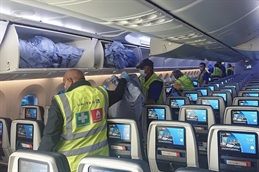
A steady increase in passenger jets flying cargo missions appears to have halted the dizzying rise in air freight pricing out of the Asia-Pacific region, notably from China and Hong Kong. Still, rates remain in the stratosphere, kept aloft by rampant demand for personal protection equipment (PPE) and a shortage of lift.
As passenger networks imploded in the face of travel bans and similar measures to stop the spread of the Covid-19 virus, the abrupt contraction of air freight capacity left a huge gap in air freight markets, notwithstanding the slump in global trade. With nearly half of the global lift sidelined and demand for PPE going through the roof, air freight rates exploded. By mid-April, forwarders were reporting prices as high as US$19 per kilo and
large widebody charters were fetching north of US$1.5 million for a trans-Pacific trip.
Freighter operators, who had been struggling a few months back and were parking aircraft, found themselves back in high demand and scrambled to boost capacity.
CargoLogicAir rushed to get its operating certificate reinstated so it could reactivate its Boeing 747-400 freighters, and Atlas Air scrambled to return two of four recently mothballed 747 cargo planes back into service.
Still, demand for lift far outstretched available capacity. According to the International Air Transport Association (IATA), demand was down 15.2% in March, while capacity had contracted 22.7%. In the Asia-Pacific, region demand dropped 15.9%, but lift was 27.8% lower.
For the beleaguered passenger airlines, losing millions of dollars a day, the sudden bonanza in cargo offered a means to alleviate the alarming cash burn, which unleashed a wave of cargo flights with passenger aircraft. By mid-May IATA had registered such flights by some 110 airlines, using about 1,100 passenger aircraft.
A number of those carriers have boosted payload on those flights by loading cargo in the cabin as well as the bellyhold of their planes.
Cathay Pacific, which had been one of the first carriers to deploy passenger planes for cargo missions, has obtained approval to put cargo in the cabins of 777s and is pursuing permission to do the same on its Airbus A330s.
A few airlines have gone even further and removed seats from 777s to augment payload capability. Air Canada was the first to do so, followed by Swiss WorldCargo.
The use of passenger planes for cargo missions quickly escalated from charters to regular operations on key routes. United Airlines is running more than 150 cargo flights a week. In mid-May, Emirates added ten routes to its global network of freighter and belly cargo services, bringing the total to 75 destinations on all continents.
Although capacity remains short of demand, the surge in cargo flights finally stopped the upward momentum of prices out of China. Freightos reported on May 13 that rates had levelled off and noted one week later that prices for some lanes out of China dropped for the first time in weeks, going down between 1% and 3%.
“Global air cargo capacity is down 25% thanks to the drop in passenger travel. But the addition of converted passenger jets to the air cargo market has succeeded in restoring or even exceeding last year’s capacity levels for most lanes out of China,” Freightos observed.
Regular belly capacity is beginning to come back as airlines move to restart passenger schedules, albeit at a modest scale. On the other side of the equation, pundits expect demand for PPE shipments to remain robust for some time, so pricing is unlikely to slump in the near term.
There are also signs that regular traffic is beginning to ramp up again. Some airlines have signed contracts with forwarders for traffic that is not related to PPE. The resumption of automotive production, which was halted in most locations, is expected to give a boost to air freight volumes.
Overall, however, there is much uncertainty how global trade flows are going to shape up in the coming months and how much appetite for shopping consumers will have as lockdown measures are relaxed in more and more countries.
The FIS Air Freight Report of April 21, strikes a cautionary note. “The post-Covid environment is, as a result of the PPE ‘bubble’ and projections for recession and a 2-year airline recovery cycle, impossible to forecast,” its authors wrote, adding that violent up- and downswings in pricing may reflect volatility in the market.
At this point forwarders still see a need to supplement available lift with charter operations. At the end of April DB Schenker announced an agreement with Icelandair to use three 767s for a daily link between Shanghai and Munich. With 45 flights initially planned, the operation uses passenger aircraft that had their seats removed.
Two weeks later, Dachser started dedicated 777 charters from Hong Kong and Shanghai to Los Angeles. Guido Gries, managing director for the Americas, said that in the main cargo on the flights is non-PPE traffic.
“We’ll use the plane in the first phase for the USA and in the next weeks [add] Mexico and Peru, and then we’ll see how it goes,” he remarked.
As pricing remains at markedly elevated levels, forwarders have also been exploring alternative modes. According to one report, sea-air has made a comeback, with rates between US3 and US$6 per kilo from the Asia-Pacific region to Europe.
Expedited ocean services across the Pacific have also been popular, such as ECU Worldwide’s LCL express service between Shanghai and Los Angeles that was launched in late March or a priority offering that CMA CGM introduced in the same month.
By Ian Putzger
Air Freight Correspondent | Toronto




